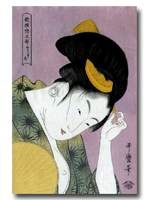Posted by Dave Bull at 5:53 PM, August 4, 2004
 We move ahead now a few months in the calendar, to mid summer, while also jumping ahead a few centuries in image style, from the Heian-era feeling of the previous image to something very much of the Edo period.
We move ahead now a few months in the calendar, to mid summer, while also jumping ahead a few centuries in image style, from the Heian-era feeling of the previous image to something very much of the Edo period.
In the 1780's and 90's the publisher Tsutaya Juzaburo and the designer Kitagawa Utamaro worked together on the production of many woodblock prints, most of them of the bijin-ga type. One of their most popular productions was a set of images that purported to depict psychological classifications of women - 'fickle', 'interesting', etc.. Perhaps in response to this success, they then came up with something similar - a set of prints entitled Kasen Koi no Bu ('Anthology of Poems: Love Chapter'), in which we meet five women drawn to depict various types of love. The five prints are titled: Reflective Love, Deeply Hidden Love, Love that Meets Each Night, Obvious Love, and Love that Rarely Meets. I chose the fourth one from the set, where the Japanese title Arawaruru Koi perhaps implies love that is 'obvious' in the sense that it can no longer be hidden ...
While involved in research for my work I studied these five designs, looking at the images very carefully, and tried to understand what Utamaro and his publisher meant with this series. Honestly speaking though, I found myself pretty much unable to see what they seemed to have intended. What is there in this image that would make us feel that the love this woman is feeling is 'obvious'? This made me think that pictures alone are really not a suitable medium for the job of communicating subtle shades of emotion from the creator to the viewer. A written-down story can do this very well of course, but an isolated image such as the one we see here? I didn't think this was possible.
To test my thesis, I made up a small quiz based on this series of five prints. I prepared reproductions of the five images (with the titles effaced), and asked people to match them up with the five titles. More than 150 people tried my quiz; not one person made a correct match of the five titles and images, and most people got no more than one or two correct. In the case of the image we see here, only 30 people out of 156 managed to make a correct match - almost exactly a random result.
There are a number of possible ways to interpret this outcome. Perhaps Utamaro was not a 'very good' artist; this is obviously ridiculous. Or perhaps over 200 years, enough cultural differences have accumulated to make understanding difficult. There certainly have been a lot of changes over that time, but in basic human emotions? I think not. Perhaps though, we are simply asking the image to carry nuances of emotion that are just too subtle; I think this is the most likely reason. I certainly agree that a basic level of emotional content in a picture is readily communicated: the person may be 'happy', 'sad', 'angry', etc. But to go much deeper than this is only possible if the image contains content that links us to an episode or event about which we already carry some knowledge. If we (for example) can see that some image represents a particular character in fiction, then we will readily be able to experience any amount of depth of emotion in the picture - because we will see what we expect to see there based on our prior knowledge of the story. But without such a connection we are lost, and must depend on the written word - the title of the work - to communicate the 'real' meaning.
There is, of course, still another possible explanation for the poor quiz results; perhaps it is the woodblock print that is incapable of such depth. After all, in prints like this every nose must be the same shape, every eye the same shape, the angle of the head always the same ... the artist really has very few means left for expressing emotion, and it is a wonder that he can give us as much as he has!
Each of us will have his/her own viewpoint on this, and in fact, one of the friends with whom I discussed these points made an interesting observation (laughing as he did so), "Dave, you're a craftsman, not an art critic. Utamaro's job was to create images. My job as a viewer is to receive his 'message'. Your job ... is to cut and print. Now get back to your bench, and leave the analysis to us!" To which I could only reply ... "Yes sir!"
I hope you enjoy this very decorative print; I haven't talked at all about why I selected it for my series - for the subtle layering of the various gradations in her clothing, for the wonderful challenge of carving and printing the double layer of delicate hairlines, for the beautiful pink mica cloud against which she is posed ... but most of all, for its quiet elegance. I still can't see 'Obvious Love' here, but I do know something beautiful when I see it!
August 2004
